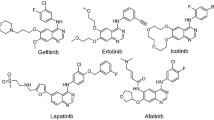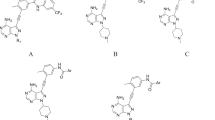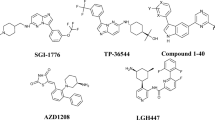Abstract
Three dimensional (3D) quantitative structure-activity relationship studies of 37 B-Raf inhibitors, pyrazole-based derivatives, were performed. Based on the co-crystallized compound (PDB ID: 3D4Q), several alignment methods were utilized to derive reliable comparative molecular field analysis (CoMFA) and comparative molecular similarity indices analysis (CoMSIA) models. Receptor-guided alignment with quantum mechanics/molecular mechanics (QM/MM) minimization led to the best CoMFA model (q 2 = 0.624, r 2 = 0.959). With the same alignment, a statistically reliable CoMSIA model with steric, H-bond acceptor, and hydrophobic fields was also derived (q 2 = 0.590, r 2 = 0.922). Both models were validated with an external test set, which gave satisfactory predictive r 2 values of 0.926 and 0.878, respectively. Contour maps from CoMFA and CoMSIA models revealed important structural features responsible for increasing biological activity within the active site and explained the correlation between biological activity and receptor-ligand interactions. New fragments were identified as building blocks which can replace R1-3 groups through combinatorial screening methods. By combining these fragments a compound with a high bioactivity level prediction was found. These results can offer useful information for the design of new B-Raf inhibitors.







Similar content being viewed by others
References
Wellbrock C, Karasarides M, Marais R (2004) Nat Rev Mol Cell Biol 5:875–885
Avruch J, Khokhlatchev A, Kyriakis JM et al (2001) Recent Prog Horm Res 56:127–156
Davies H, Bignell GR, Cox C et al (2002) Nature 417:949–954
Tuveson DA, Weber BL, Herlyn M (2003) Cancer Cell 4:95–98
Houben R, Vetter-Kauczok CS, Ortmann S, Rapp UR, Broecker EB, Becker JC (2008) J Invest Dermatol 128:2003–2012
Hansen JD, Grina J, Newhouse B et al (2008) Bioorg Med Chem Lett 18:4692–4695
Noble MEM, Endicott JA, Johnson LN (2004) Science 303:1800–1805
Cramer R III, Patterson D, Bunce J (1988) J Am Chem Soc 110:5959–5967
Klebe G, Abraham U, Mietzner T (1994) J Med Chem 37:4130–4146
Klebe G, Abraham U (1999) J Comput Aided Mol Des 13:1–10
SYBYL 7.3 TI, 1699 South Hanley Rd., St. Louis, Missouri, 63144, USA
LigPrep v2.2, Schrödinger, LLC, New York, NY (2005)
Wold S, Sjöström M, Eriksson L (2001) Chemom Intell Lab Syst 58:109–130
Kettaneh N, Berglund A, Wold S (2005) Comput Stat Data Anal 48:69–85
Tetko IV, Tanchuk VY, Villa AEP (2001) J Chem Inf Comput Sci 41:1407–1421
Liao SY, Qian L, Miao TF, Lu HL, Zheng KC (2009) Eur J Med Chem 44:2822–2827
Chen Y, Li H, Tang W et al (2009) Eur J Med Chem 44:2868–2876
MacroModel v9.6, Schrödinger, LLC, New York, NY (2008)
Phase v3.0, Schrödinger, LLC, New York, NY (2008)
ConfGen v2.0, Schrödinger, LLC, New York, NY (2008)
Buolamwini JK, Assefa H (2002) J Med Chem 45:841–852
Patel MR, Dimmock JR, Talele TT (2007) J Chem Inf Model 47:2110–2123
Philipp DM, Friesner RA (1999) J Comput Chem 20:1468–1494
Cho AE, Guallar V, Berne BJ, Friesner R (2005) J Comput Chem 26:915–931
QSite v5.0, Schrödinger, LLC, New York, NY (2008)
Acknowledgments
We thank Jung Soo Oh of Computational Science Center, Future Fusion Technology Division, at KIST for helpful discussions. This research was supported by Basic Science Research Program through the National Research Foundation of Korea (NRF) funded by the Ministry of Education, Science and Technology (2009-0072095; AEC, JYC) and (2009-0087992; JMH).
Author information
Authors and Affiliations
Corresponding author
Rights and permissions
About this article
Cite this article
Chung, J.Y., Chung, H.W., Cho, S.J. et al. QM/MM based 3D QSAR models for potent B-Raf inhibitors. J Comput Aided Mol Des 24, 385–397 (2010). https://doi.org/10.1007/s10822-010-9337-5
Received:
Accepted:
Published:
Issue Date:
DOI: https://doi.org/10.1007/s10822-010-9337-5




